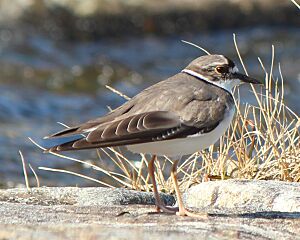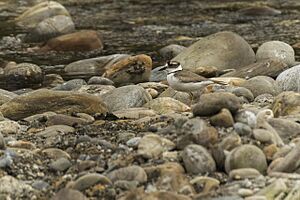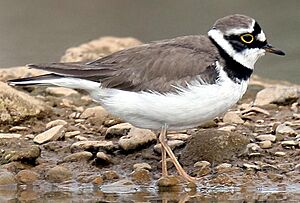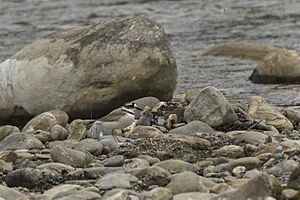Long-billed plover facts for kids
Quick facts for kids Long-billed plover |
|
|---|---|
 |
|
| Conservation status | |
| Scientific classification | |
| Genus: |
Charadrius
|
| Species: |
placidus
|
The long-billed plover (Charadrius placidus) is a type of wading bird. These birds live near water and have long legs. They belong to the Charadriidae family, which includes other plovers.
You can find the long-billed plover in many countries across Asia. This includes places like China, Japan, India, Russia, and Vietnam. It is a migratory bird. This means it travels long distances. It breeds in some areas and spends winter in warmer places.
These plovers often live along rivers, streams, and in wetlands. They also like rice fields. They search for food along the water's edge. Their diet mainly includes water insects, insect larvae, and other small invertebrates. It's hard to tell males and females apart because they look very similar.
The breeding season for these birds starts in late February or early March and ends in July. A male and female form a pair and stay together. They protect their home area during this time. In 2016, experts checked the global population of the long-billed plover. They found it was a species of "least concern" on the IUCN Red List. This means it is not currently in danger.
Contents
About the Long-billed Plover
Size and Appearance
The long-billed plover is a medium-sized wading bird. It is about 19 to 20 centimeters (7.5 to 8 inches) long. It weighs around 41 to 70 grams (1.4 to 2.5 ounces). Males and females are similar in size. Their wings are about 14 to 15 cm (5.5 to 6 in) long. Their tail is about 7 to 8 cm (2.8 to 3.1 in) long. The bill is about 2 cm (0.8 in) long.
Both males and females have a grayish-brown back. Their belly and throat are white. They have a white forehead with a black band across their eyes. This white patch goes down to the base of their bill. Below their throat, they have a black band across their chest. Their eyes have a yellow ring, and a white stripe is above each eye.
During the breeding season, males and females look a little different. The black bands on the male's forehead and chest are wider and darker. The feathers around the male's eyes are also much darker. The male's white eye-stripe goes further back behind the eye. Young plovers look a lot like adults. However, they do not have the dark forehead band. Their chest band is also narrower and not as clear as an adult's.
Telling Similar Plovers Apart
The long-billed plover can sometimes be confused with the Little ringed plover. This is because they live in some of the same areas and look alike. But you can still tell them apart. The long-billed plover is bigger. As its name suggests, it also has a longer and thicker bill.
Adult male little-ringed plovers have a solid black bar above their bill. They also have a black forehead band. The feathers around the eyes of a little-ringed plover are black. The long-billed plover has brown cheek feathers. The yellow eye-ring on the little-ringed plover is also much brighter. The chest band of the little-ringed plover is usually wider in the middle. The long-billed plover's chest band is usually the same thickness all the way across.
Plover Family Tree
The long-billed plover is one of many types of plovers. It belongs to the Charadrius group. This group is part of the Charadriidae family. This family includes plovers, lapwings, and dotterels.
The Charadriidae family is part of a larger group called Charadriiformes. This group includes many different shorebirds. For example, gulls, terns, auks, and sandpipers are all in this group. The long-billed plover was first described in 1863 by J. E. Gray and G. R. Gray. So far, no different types (subspecies) of the long-billed plover have been found.
Where Long-billed Plovers Live
The long-billed plover lives across South and East Asia. It is not very common and is usually seen in small groups. They breed in places like western, northern, and central China, Japan, North Korea, and South Korea. They have also been seen breeding in parts of Russia and India. Sometimes, they even breed in Singapore.
These birds fly south for the winter to warmer places. They spend winter in eastern Nepal, northeast India, southern China, and parts of Japan. They also winter in Taiwan, Myanmar, Malaysia, and Thailand. Some long-billed plovers in Japan stay there all year. Only those from Hokkaido travel south for winter.
Long-billed plovers like to live near rivers, streams, and lakes. They prefer places with small, round pebbles and rocks. They often build their nests on small, temporary islands made of pebbles. These islands form between the different parts of winding mountain rivers. These islands need to be at least 600 square meters (6,458 square feet) in size. They also need large areas of stones and pebbles that are 30 to 60 millimeters (1.2 to 2.4 inches) big. Their homes are often surrounded by shrubs, willow trees, and young forests.
In winter, you can also find long-billed plovers in freshwater wetlands and rice fields. They usually avoid sandy beaches, mudflats, and areas with very large rocks.
Plover Behavior
Sounds and Calls
The long-billed plover makes many different sounds. They are very noisy during the breeding season. You might see them flapping their wings fast over their territory. They make a "fi-fi-fi-fi-fi" call. Males sometimes make a quiet "gee gee" sound. They do this when they puff out their chest to scare away other males.
When they are watching out for danger, they make a single rising "pyuoo-" call. If they are hiding from a predator, they make a "pip-pip-pip" sound.
What They Eat
We don't know a lot about what long-billed plovers eat. But we think their main food is water insects and other small invertebrates. People have seen them eating midges, dragonflies, and the larvae of beetles and flies. They also eat earthworms.
Long-billed plovers look for food along the water's edge. When they see something to eat, they quickly move towards it. Then they catch it with their long bill. They do not seem to eat any plants. Other similar plovers, like the Common ringed plover, eat small shrimps. So, long-billed plovers might eat similar small sea creatures too.
Reproduction and Life Cycle
Long-billed plovers usually have one partner for breeding. A male and a female form a pair. They set up a territory and protect it together. Sometimes, a female might leave her nest to breed with another male. But males usually stay in their territory. Both males and females fight to protect their home. They fly around, make loud calls, puff out their chests, and sometimes jump or peck at intruders.
Males start breeding in late February or early March. The male uses his feet to move gravel. He makes a shallow dip in the ground. It is about 4 cm (1.6 in) deep and 13 cm (5.1 in) wide. He presses his chest against the ground to shape it. The male calls to attract a female. When a female comes, the male spreads his tail to show off. The female walks under his tail and into the nest. The male makes many of these dips. He guides the female from one to another. The female eventually lays her eggs in one of them.
She lays one egg every 48 hours until she has four eggs. Each egg is usually about 3.5 cm (1.4 in) long and 2.6 cm (1 in) wide. They weigh about 10 to 13 grams (0.35 to 0.46 oz). The eggs are pear-shaped. They are grayish-brown or bluish-gray with tiny brown spots.
Both parents help take care of the nest. They line it with small pebbles, twigs, and dry plant parts. Both the male and female also take turns sitting on the eggs to keep them warm. The eggs usually hatch 29 days after they start being incubated. This time can change if people disturb the nest.
Long-billed plovers are good parents. If a predator comes near the nest, the parents try to scare it away. They make loud distress calls. On very hot days, the parents stand over the eggs. This shades them from the sun and keeps them from getting too hot.
Baby plovers are called precocial offspring. This means they can move around and find food by themselves soon after hatching. The parents watch their babies closely. They are always looking for any signs of danger. The babies gain about 1 gram (0.035 oz) of weight each day. They are ready to fly when they are about 40 days old. Young plovers stay with their parents for a short time. Then they leave the nest and fly to their winter homes.
These plovers often return to the same breeding spots year after year. This means the same pairs use the same nesting areas. They start setting up their territories even when there is still snow. This shows they remember good nesting places from before.
Conservation Status
The long-billed plover is listed as a species of "least concern" on the IUCN Red List. This is because it lives in a very large area. Its home range is bigger than 20,000 square kilometers (7,722 square miles). The number of long-billed plovers seems to be going down. However, the decline is not fast enough to make them an endangered species right now. A species is considered vulnerable if its population drops by more than 30% in ten years.
Even though they are not in danger now, their numbers might drop quickly in the future. This could happen if they lose their breeding grounds. So, it is important to protect and fix their breeding habitats. Projects to restore habitats can create new nesting places. This can be done by building gravel banks and pebble islands.
|





